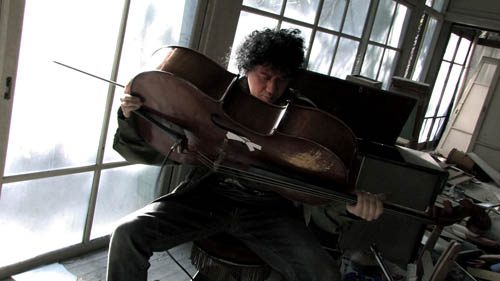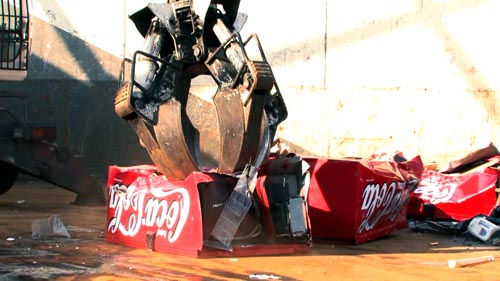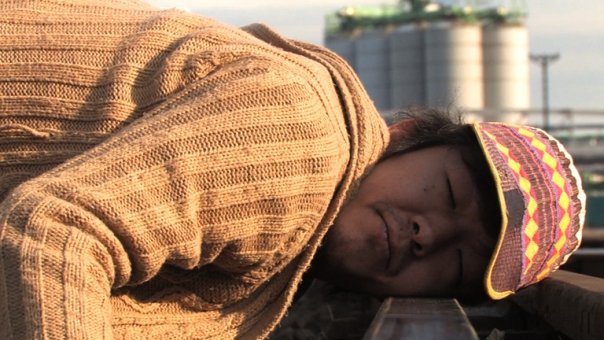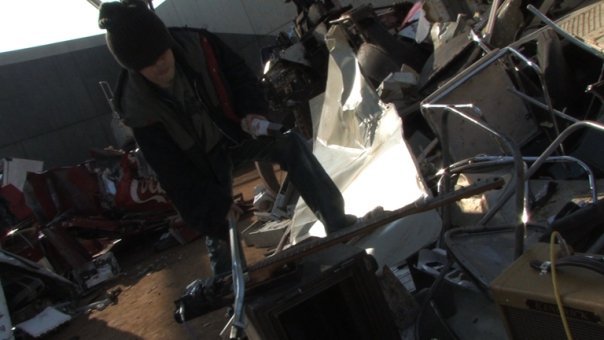An Interview with Gaspard Kuentz and Noa Garcia

IN JAPAN EVERYTHING MAKES SOUND: AN INTERVIEW WITH GASPARD KUENTZ & NOA GARCIA
Ahead of this week’s screenings of WE DON’T CARE ABOUT MUSIC ANYWAY, The Onion Cellar chatted to Gaspard Kuentz and Noa Garcia from Studio Shaiprod about the making of the film, the soundscapes and landscapes of Japan, and how every citizen in Tokyo is a potential sucker for sounds..
The Onion Cellar (TOC): First question, I’m quite curious as to what led you to make a documentary on the Tokyo’s experimental music scene, as opposed to something about the French scene?
Gaspard Kuentz (GK): Well, I have been living in Tokyo for more than 10 years now, as the music director of the film, Noa Garcia. That’s why we knew the scene and most of the musicians starring in the film. Some are long-time friends, some of them we just contacted when we decided to make a film.
Beside that fact, the Japanese scene of free music – or improvised or experimental music – is far more interesting than the French one, and far more diverse too. Every musician of the film is from a different genre and uses different means to create sound: turntables for Otomo Yoshihide and L?K?O, cello for Sakamoto Hiromichi, voice and body for Yamakawa Fuyuki, or electronics for people such as Numb and Saidrum. They all come from different backgrounds but still have similarities in their free approach on music and live performance. That was what interested us in the first place.
TOC: Thanks, now that you mentioned it, what do you think led to this diversity that is seemingly unique to the Tokyo’s scene? I have also lived in places like London, but I certainly was not aware of any movement that is in the least bit similar and as adventurous as what is going on in your film.
GK: That’s a difficult question! Well, I am not sure if you can talk of a “movement” about the scene here. These musicians don’t really form a movement and they don’t belong to a genre in particular. But I think that the main reason it is so diverse might be that people are very curious and less “selective” than in Europe. In France, a hip-hop party is a hip-hop party, and no one playing free rock could ever make it there. Here, the events in the clubs are more free form. And people are more open about different music forms.
The other thing is that in Europe, free music is often seen as art, I mean in the meaning of elitist art and all free and experimental music events are held in museums, which are not as popular as clubs. So it’s not that fun you know. It’s more rock n’roll here!
[at this point – Noa Garcia – the musical director of the film joined us]
TOC: Back to what we were talking about, that diversity, do you think it also has something to do with history? After World War II Japan seemed to recover so quickly, I guess they started again from scratch, and as a result they seem to have this motivation, this willingness to just explore everything.

GK: I could not say, but it is true that Tokyo especially has great access to all kinds of music, from all over the world, and people are very curious and passionate about music – not only about music, but about almost everything that might interest you. And it also has great access to second hand instruments, effects, machines and all you can dream of to create music. So it definitely makes it easier to create different things than what is usually done in popular music.
But what we wanted to show in the film is how close these forms of music are to the movement of the city, how it responds to the crazy consumerism and never-stopping open air market that this city is, in some way. That is only our personal view on this music, but we felt it was deeply linked with the city it is made in.
TOC: Your answer conveniently brought me to what I want to ask next. Watching the film I certainly get the impression that it is about music and sounds as much as it is about consumerism, capitalism and conformity. Was this direction something you guys deliberately tried to follow, or was it influenced by the characters / musicians?
Noa Garcia (NG): This is definitely on us. I guess.
GK: To answer your question, you cannot say that any of the musicians has any direct critical discourse about what they are doing. They won’t say to you that they hate capitalism and that they are trying to fight it. I think they work on a level that more revolves around perception of sound and on its limits. But I think that you also can say for sure that their music doesn’t come from nowhere: It comes from here, and here is pure liberal capitalism, with no or almost no rules.
So I would say that of course, the film is written, shot and edited following our point of view, but still the clues we used are in the music as well. Noa, what would you say?
NG: I agree with you about the first part. I think that the elements we borrowed from their music relied a bit more on our own interpretation of their music. I don’t think there is anything explicitly anti-capitalist or anti-conformist in their music.
TOC: So in other words, they also don’t care about politics?
NG: This aspect is, in my opinion, much more central to us than it is to them.
GK: Well no musician of the film ever said they did not care about music as well. We chose the title, some musicians liked it, some did not. They’re not activists, for sure, but that doesn’t mean they don’t care about politics. I think they all care about politics in some way, especially now.
NG: That’s true.
GK: And I also think that to choose to make a living with experimental music in a society like the Japanese society is a political choice anyway.
NG: It is a radically political posture, but to the audience discretion.
GK: Well just to add that if the film might have more political aspects than the music holds in itself I still don’t think that it is a political film in a strict way. It has critical aspects but finally it is more about music and physical impact of sound on the viewer.
TOC: Right. Apart from all the performances in the film we get to hear lots of different sounds of the city itself. How did you decide what sounds to get, or was it ‘improvisation’ / using everything?

NG: First of all, Tokyo is a city of sound. Every machine has a synthetic voice giving instructions; every train station has a melody to time the closing of the doors being just a few examples. We decided from the very beginning that these sounds would take a great part in the city’s sonic identity in the film, and that we wanted to transmit these ambient sounds to the audience. We were not really sure about the way we wanted to use them but we knew from the very start that they would be a great part of the audio footage of the film. The form in itself is almost entirely to the credit of Jaike Stambach, our sound designer.
TOC: That I completely agree though having never been to Tokyo or Japan before, yet do you think that also makes Tokyo citizens potential suckers for sounds, in a direct or indirect way? I mean, such an ideal environment there that could possibly & potentially renders anything into something unique. I once worked with some late-middle-aged Japanese, and staying late at the office helped me discover that they listen to literally all genres of music, quite some of them deemed inappropriate for people at his age.
NG: That is an interesting point you’re bringing here. Actually the impact of those electronic jingles and voices everywhere is tremendous and I imagine that this is one of the things that kind of shock people when they come to Japan for the first time, but we were surprised to learn that most of the musicians of the film did not really give any special attention to those sounds. It was more like if they were part of a whole as opposed to our perception of them as pointing of the maelstrom.
GK: About the use of the soundscape of the city in the film, I would just like to add that this is also one of the reasons we had the musicians playing in open air spaces, or at least spaces they were not used to play in. It was a way to have them improvise with the space itself, and the sounds of these spaces (planes, machines etc).
NG: Yeah, I forgot something too..
GK: Go on.
NG: I wanted to talk about the field recordings and their editing actually. So this is the work of Jaike Stambach, as I said earlier, but we wanted the soundtrack of the film to be edited so that it could be listened to without the visual footage as well. This ‘continuous mix’ wish led us to the final form and Jaike was the architect of this structure. There are several of his own compositions in the film, they are almost entirely made from the field recordings he led during the shooting in Japan.
We chose to gather a lot of audio materials with no real method or target. We recorded basically everything around because in Japan everything makes sound. He sorted it out back in the studio in Paris. He really is a key person in the audio identity of the film in that he was the right person for this. All the musicians of the film are quite cautious when it comes to their music.
GK: He also remixed the sound of the film for the soundtrack CD, and all musicians were very happy with it.
NG: In the end they were.

TOC: As you mentioned the places, I was just about to ask if you guys could tell us something about those places where you filmed the performances. For instance, this large hall where Numb & Saidrum played, with all the arches. I have to say it looks very futuristic
GK: Yes, this has been used a lot in Power Rangers like hero dramas. It is a huge tank for rain water, draining all the water from the Tokyo region. It is around 80 meters high. It is true we had that “end of the world” image in mind when choosing the spaces for the performances. Our idea was to choose places that had been dropped or put away by society, such as industrial ruins and trash dumps. We wanted to use them to contrast with the clean face of the city.
TOC: And all those places did bring out something from the performances, something different from when they played in their usual environments?
GK: Definitely yes. We talked with the musicians before choosing the places and did location hunting as well to make sure they would be interesting in a musical way too. For example, Yamakawa Fuyuki wanted to play in a cave, as he had the image of primitive men discovering singing in caves, and so on.
I must admit that some of the places were not optimal for sound making, but we always did it in a way that musicians were really amplified; all the music performances are real time, no cheating. All the musical gestures that you see in the film really correspond to the sound. That was very important for us as we believe this is a performance-oriented music: all is in the gesture and the sound you get from that very particular gesture.
TOC: Ok for a last question from me, how are things going in the scene there at the moment? Is it still developing and branching out?
GK: Well for myself, I tend to think it used to be more active before, in fact even before the shooting of the film. Lot of clubs have closed, and it has become more and more difficult to live from music due to economic reasons mainly. But musicians are still active so it’s not all so negative.
TOC: I would like to think it’s the same situation everywhere.
GK: Definitely. But there are a lot of talented musicians here and the film only presents 8 of them.
NG: Almost a year ago, just after the earthquake-tsunami, we toured Europe with the musicians of the film, after Otomo and Yamakawa cancelled because of the disaster. It was the final tour for Umi no yeah!!!, they split since. Numb & Saidrum don’t play together anymore. L?K?O has now moved to Thailand.
GK: Which makes it easier to have him perform in Vietnam!
TOC: I guess in that way, given what happened afterwards the film would feel more special? As it was like a snapshot of that particular period that has sort of changed now.

GK: That’s true. Some people in Europe saw images of the tsunami in the beach scene but the film was completed in 2009 so it’s not related at all.
NG: But there are many artists still very active, actually all the musicians of the film with the exception of Shimazaki Tomoko are still performing.
TOC: I hope things will keep moving forwards for the scene and artists there.
NG: Thank you very much for the effort you are making in having all of this happen in Vietnam. We are very grateful.
GK: Yes and hope you can make it sometime to have Japanese artists play in Vietnam. I’m sure most of them would be very happy to have the opportunity.
TOC: We do hope so. In a perfect world I would be happy to invite a few musicians from the film to come play in Vietnam for the screenings, but financially it is difficult.
GK: We understand that, the film was made under tough financial conditions too.
TOC: How long did it take to get the project going?
GK: From the idea to completion, around 2 years and a half, but it definitely would have been real faster with more money!
TOC: So, thanks a lot for taking the time to answer our questions. Bye then and have a nice evening.
NG: Thank you again and goodbye.
GK: Thank you!
















